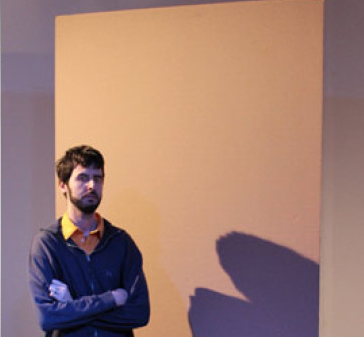What led you to the work you’re making now? I’m especially curious about the transition from the work you were doing with banjo to a more sculptural practice.
I came to the current performance work from a number of pathways, one being my frustrations working within the limitations of the more codified ‘improvised music’ context. While I was primarily playing banjo, I also worked with Maryanne Amacher and Ei Arakawa, two very different artists who dealt with the performance environment in very interesting ways. When I saw their performances as an audience member, I could engage in such different and more meaningful ways than just sitting quietly and stiffly in my chair.
However, there are parallels between the current work and my previous performances as a banjo improviser. I was using transducers within the banjo, and I was interested in the significance of this particular object as sound source and all of the cultural baggage that went along with it. This focus has shifted from the banjo to the other objects that make up the space and constitute a performance, such as tables, chairs, stage curtains, etc..
How is the Schindler House location influencing your performance?
I am really excited to get to respond to Schindler’s Kings Road House. Schindler was using form to define space, and redefine notions of interior/exterior and their common social usage. This makes the house a much more dynamic space than the performance venues and galleries I am accustomed to.
I hope to extend the underlying features of the house into the performance, playing with this binary of interior/exterior and how this could extend into modes of listening, such as public versus domestic listening.
We’ve asked you to extend your performance to 4 hours. I’m going to steal a question from the Prepared Guitar blog and ask how you experience time in music? How do you use time as an element in your work?
Historically in Western music, we have had institutional structural cues that many would consider ‘extra-musical’, such as the rituals around beginnings and endings, to know that we are now experiencing ‘music’. These are also traditionally cues to tune out the sounds of other bodies, the air conditioner, outside traffic, and most of our quotidian world. Assuming the audience isn’t actually coming beforehand and sitting politely for four hours, the time element is useful here as a means of avoiding some of those cues. I have a habit of not formally ending performances as a tactic for blurring the boundary of ‘music’, where we say these elements are musical and these elements are not.
What’s next for you?
I am doing a few shows on the East Coast with a much more mobile, portable version of this installation work. I became interested in origami after learning that NASA had used folding techniques to fit giant solar panels into rockets. So, I’ve been looking at similar techniques for fitting installations in my car for traveling!
I also have a ton of work to do with my co-editor Bill Dietz on Issue #2 of Ear | Wave | Event, a web publication launched earlier this year focusing on issues around sound/music.
Who are some other musicians and/or artists you admire and why?
I’ve admired artists who work in music but also in other media, mainly because it is interesting to consider how music functions similarly to other art forms as well as what makes it unique. So I enjoy most of the work of artists like Max Neuhaus, Maryanne Amacher, Michael Snow, Tony Conrad, etc..
Please pick a favorite or stand out clip/track from our archives and tell us why you chose it.
I’m a big fan of Pauline Oliveros’ pieces for audiences although I don’t think I’ve ever watched a video of one before which is such a different experience. In person, you are an active listener and participant, experiencing other audience members in a way that is in opposition to modern notions of listening in the concert hall. Pauline really excels at making these inviting situations that don’t feel forced as ‘audience participation’.
